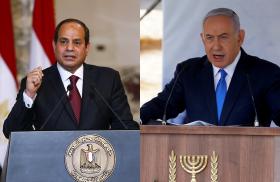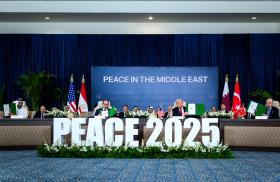- Policy Analysis
- Articles & Op-Eds
The Benefits of Disarming Hamas Are Clear. What About the Price?
Also published in Times of Israel
Even if Washington were willing to support indefinite military occupation, escalating in Gaza would increase the risk to hostages, the strain on the IDF’s reserves, and the discord Israel has faced at home and abroad.
In the last several days, a debate has emerged between the Israeli cabinet and the defense establishment over how to approach renewed fighting in Gaza. Finance Minister Bezalel Smotrich and IDF Chief of Staff Lt. Gen. Eyal Zamir clashed over the issue during a security cabinet meeting last week. Zamir argued that the IDF should not be responsible for distributing aid in Gaza, with Smotrich responding, “If you are not capable, we will bring in someone capable.”
Despite the heated exchange, the core debate appears to center on the timing, scope, and pace of operations, not the overall direction of the war. According to reports, the IDF favors a more incremental approach, seeking to gradually widen the IDF’s footprint rather than carry out a full-blown attack (which many in the cabinet reportedly prefer). Despite this, it seems the overall goal of securing full control of Gaza is shared, at least for now.
What seems to be a new part of the Israeli calculus is a shift of focus from toppling Hamas to disarming the group. This, after Israel rejected the Arab League’s proposition in early March that advocated for a government of Palestinian technocrats to take control of Gaza. Israel sees such a plan as insufficient, believing that if Hamas can fire the shots, it will also call the shots in Gaza, even if it is not formally a part of the government.
The fear is that Hamas could be as dominant as Hezbollah was in Lebanon until its leadership was decimated by Israel last fall. In other words, no Arab or Palestinian interim administration is going to take over Gaza if Hamas has an estimated 20,000 armed fighters.
To achieve the goal of disarming Hamas, it seems there is a plan for Israel to assert sustained military control over Gaza for the foreseeable future. Until now, Israel has been unable to topple Hamas, partially due to its control over civilian life. Hamas remains in power by hijacking humanitarian aid and using it to replenish its dwindling financial resources through resale on the black market, all while taking credit for feeding the Gazan people. Sources close to the prime minister insist that by having the IDF take on aid distribution, Israel will be able to “cut off Hamas from the people of Gaza.”
These officials believe it is unrealistic to expect an alternative Arab-Palestinian interim administration to take control of Gaza until Hamas is soundly defeated. Until then, no Arab or Palestinian force will risk armed encounters with Hamas. Taken together, there could be genuine value in ensuring that Hamas terrorists cannot regain control of Gaza and not threaten Israelis in the future.
The Price Israel Will Pay
The Israeli government will make its decision on how best to secure the Israeli people. Yet, every policy judgment requires looking at both sides of the cost-benefit ledger to reach the best possible result. It bears asking: What are the costs on the other side of the ledger? If disarming Hamas is the goal Israel chooses to prioritize, the Israelis must go into this new phase of fighting with eyes wide open to the potential consequences.
First, there is a very real risk that the lives of the remaining hostages in Gaza would be put in peril. Netanyahu paints military pressure as an unalloyed good. However, Israeli officials acknowledge that several of the 37 hostages killed during the war were unintentionally killed by Israeli bombing. Thus, one cannot assume the remaining hostages will come out alive, especially considering they have already spent a year and a half deteriorating in Hamas tunnels, and their value to captors will drop dramatically if there is no deal to be had.
Second, renewed fighting will also have serious implications for Israeli military personnel as well as noncombatants in Gaza. Israeli officials suggest the IDF would need to occupy Gaza for at least a year, if not much longer. This would significantly increase the responsibilities of Israeli reservists, many of whom have served 200-300 days since October 7, as they would be in charge of food distribution in Gaza, among other duties.
This comes at a time when reserve rates are already plummeting. While the IDF says, officially, that the rates of those reporting to duty when called are down about 30%, analysts assess the reduction as closer to 50%. Petitions of reservists will probably grow, saying it is a mistake to prioritize fighting over the release of the hostages. Further, the new round of fighting will take place amidst increased domestic division in Israel, with thousands taking to the streets to protest the government’s failure to return the hostages and the firing of Shin Bet Chief Ronen Bar, among other grievances.
In terms of the Gazan people, Israeli officials say they plan to direct all aid trucks to the Muwasi beach humanitarian zone in southwest Gaza, requiring the Gaza population that moved north during the ceasefire to return south. Israel hopes to create a humanitarian zone there so it can conduct military operations in the rest of Gaza and be in charge of food distribution.
However, it remains unclear whether Israel will be able to ensure Hamas fighters get filtered out of this zone. After all, Hamas is an army that puts on its uniforms during the cease-fire and takes them off during the fighting. Yet, Israeli officials insist they will be able to isolate Hamas from the civilian population, doubtlessly buoyed by the recent Gazan demonstrations against Hamas.
There is also no guarantee such a campaign will be quick, as evidenced by the year and a half of inconclusive fighting in Gaza. Hamas cares little for its people, so heightened military pressure alone may not persuade ideological terrorists who have so far been willing to see Gaza destroyed for the sake of maintaining control there. Further, the last year and a half of war has likely radicalized many civilians in Gaza who blame Israel for the death of their loved ones.
Thus, it seems entirely possible that Israel could have initial military successes in Gaza, only to get stuck with open-ended military control and face an open-ended insurgency. It is worth noting that the impact of Israel’s heavier hand could well be to feed an insurgency.
Finally, assuming the Netanyahu government intends to ramp up the fighting and occupy Gaza for an extended period, what is Israel’s plan to keep the US on its side? While President Trump has famously said that “all hell” will break out if Hamas does not release the hostages, it is not clear if this is an open check to have Israel stay in Gaza without a plan for the conclusion of fighting. This is especially critical as Trump is known to be impatient when it comes to forever wars.
For Hamas disarmament through military action to succeed (if it is even possible), articulating a broader objective for a post-Hamas Gaza is paramount. Without a clear plan for who will govern Gaza, Israel risks becoming more isolated internationally. Framing the goal of disarmament as a means to achieve a future for Gaza governed by Arabs, not Israelis, would give Israel’s aims more legitimacy in the eyes of the world.
Lebanon is a case in point: There are early signs of the successful disarming of the Iran-backed terror group in southern Lebanon, but this is happening because the war with Israel is followed up by a legitimate Beirut government acting against a group it sees as having hijacked the country for decades.
Likewise, Israel should, today, adopt the objective of ultimately turning Gaza over to some kind of Arab governing coalition after the fighting ends. This framing would also reflect the broader goal of conveying that Israel does not seek to annex or occupy Gaza, especially as many Israelis view remaining in Gaza as a liability rather than an asset.
Specifically, it could be helpful to have the Palestinian Authority return to Gaza. Israel could link the PA’s return to Gaza to reform of the PA or perhaps even working with Gulf Arab states like the United Arab Emirates, which has curricula in its educational system against radicalization. So far, Israel is not willing to accept a PA presence in Gaza. However, Netanyahu’s government politically cannot articulate a ‘day after’ strategy as hard right elements seek open-ended control of Gaza despite the opposition of the defense establishment.
As talks over hostages have been stuck, Israel is already ramping up the fighting in Gaza and the prospects of a significant escalation are rising. The Netanyahu government clearly prioritizes defeating Hamas on the battlefield over other objectives and will make its decisions accordingly. Yet to win broad support, Israel must demonstrate it is weighing its options carefully. If renewed fighting is the path Israel chooses, it must think seriously about how to execute it without becoming mired in an indefinite Israeli military occupation, facing an insurgency, and alienating President Trump.
Netanyahu has long prided himself on his ability to persuade the public. Yet true leadership requires him to be as explicit about the formidable risks ahead as he is about the anticipated benefits of returning to war on the road to reaching a crucial policy judgment.
David Makovsky is the Ziegler Distinguished Fellow at The Washington Institute, director of its Koret Project on Arab-Israel Relations, and creator of its long-running podcast Decision Points. Simone Saidmehr is a research assistant with the Koret Project. This article was originally published on the Times of Israel website.



